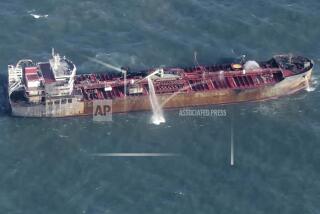Blaze Sweeps Navy Destroyer; 1 Dies, 12 Hurt
- Share via
WASHINGTON — A predawn fire Tuesday killed one Navy officer and injured a dozen sailors aboard the guided-missile destroyer Conyngham, which was left for hours without communications and dead in the water off the North Carolina coast.
The blaze forced the captain to evacuate the bridge and the combat information center while the 380-man crew battled the main engine-room fire and a series of secondary fires.
The dead officer was identified as Lt. A. Pope Gordon Jr., 34, of Virginia Beach, Va., son of a U.S. bankruptcy judge in Montgomery, Ala. He left a wife and three young children, Navy officials said.
Pentagon spokesman Bob Hall called it a “serious fire,” but said the ship’s weapons and ammunition stores had not been affected by the blaze. The Conyngham was not equipped to carry nuclear weapons, according to knowledgeable sources.
The accident was the first major Navy mishap in months. Last year, a string of deadly disasters forced an unprecedented two-day suspension of all training activities to determine whether the service had systematically neglected safety procedures.
After the worldwide safety review, Chief of Naval Operations Adm. C. A. H. Trost concluded that no single thread linked the unusual accidents, but blasted his subordinates for serious lapses in training and discipline.
The Conyngham is one of 23 Adams-class destroyers built in the late 1950s and early 1960s, all of which are scheduled for retirement in the next five years. It has not been determined whether the accident would accelerate the Conyngham’s planned 1991 decommissioning, a Navy official added.
The Adams class carries guided missile launchers, guided missiles, 5-inch guns and torpedoes.
The cause of the fire was under investigation late Tuesday as the disabled vessel was towed to its home port at the Norfolk Naval Station.
The fire erupted in the main boiler room at 5:35 a.m. as the 437-foot ship was sailing about 80 miles off the coast of North Carolina in what the Navy calls the Virginia Capes Operating Area, officials said.
“The fire spread to the combat information center spaces, which caused the captain to evacuate the combat information center and the bridge, temporarily leaving the ship without communications and dead in the water,” White House spokesman Marlin Fitzwater said.
The combat information center, or CIC, houses all of the ship’s communications equipment, its weapons fire-control systems and its sonar and radar gear.
The Conyngham’s skipper, Cmdr. W. R. Williams, reported that the main fire was extinguished within two hours but that the crew fought secondary blazes until noon.
The guided missile cruiser Normandy and the destroyer Briscoe moved in to assist the Conyngham in fighting the fire, as did three Coast Guard cutters and Navy and Coast Guard helicopters. The injured were taken by helicopter to hospitals ashore, according to Chief Petty Officer Bobby Gimblet, an Atlantic Fleet public affairs officer.
Gimblet said the Conyngham was able to move under its own power en route to Norfolk at about 2 1/2 knots until midday, when it lost power about 60 miles east of Norfolk. It was then towed by the Navy salvage ship Opportune.
“At the present moment we do not have a cause of the fire. That will come out after a naval investigation,” the Navy spokesman said.
The injured sailors were at Portsmouth Naval Hospital late Tuesday; officials listed four in guarded condition and eight as stable. The Navy said nine had burns and three suffered smoke inhalation.
In May, 1987, the Conyngham helped rescue the guided missile frigate Stark after it was hit by missiles from an Iraqi jet in the Persian Gulf. Sixty Conyngham crew members were decorated for valor for their actions in fighting the fire aboard the Stark and evacuating the wounded and dead. The Conyngham later towed the disabled Stark to port.
In 1988, an Irish teen-age girl stowaway was discovered aboard the ship as it made its way back from Ireland. She was found in a 2 1/2-by-15-foot passageway where she had hidden for 10 days. Four crew members were court martialed for helping to conceal the girl.
The 1989 mishaps include the gun turret explosion aboard the battleship Iowa. Although the Navy concluded the blast was probably caused by a suicidal seaman, congressional investigators and the seaman’s relatives and friends continue to heatedly dispute the theory.
The explosion was followed in November by five accidents in six days, leading to the suspension of most routine operations during the safety review.
On Nov. 6, a Naval Reserve A-7E Corsair jet crashed into an apartment in an Atlanta suburb, killing two residents. On Nov. 11, two Navy A-6 jets mistakenly dropped bombs on a public camping area in California, injuring one camper.
The next day, the destroyer Kincaid collided with a Singapore merchant vessel, killing one U.S. sailor. On Nov. 14, fire injured 27 people on the amphibious assault ship Inchon while it was undergoing repairs in Norfolk.
USS CONYNGHAM Commissioned: July 13, 1963 Built by: New York Shipbuilding Corp. Displacement: 4,825 tons fully loaded Dimensions: 437 feet long, 47 feet wide Armament: 2 five-inch guns, torpedoes and surface-to-surface missiles Main propulsion: 2 steam turbines, 4 boilers Speed: 30 knots Range: 6,000 miles at 15 knots Crew: 360 (includes 20 officers)
Source: Jane’s Fighting Ships
More to Read
Sign up for Essential California
The most important California stories and recommendations in your inbox every morning.
You may occasionally receive promotional content from the Los Angeles Times.













